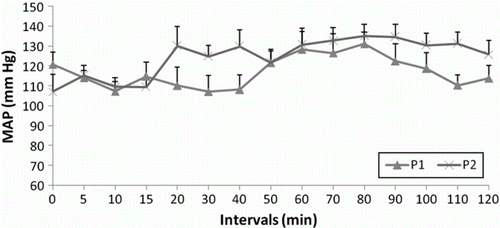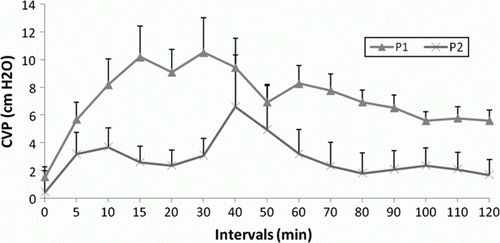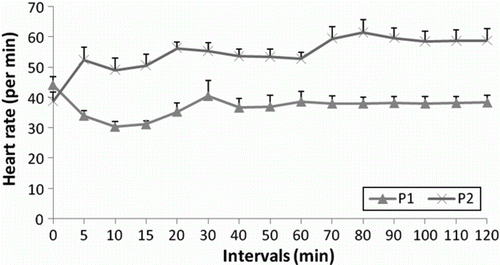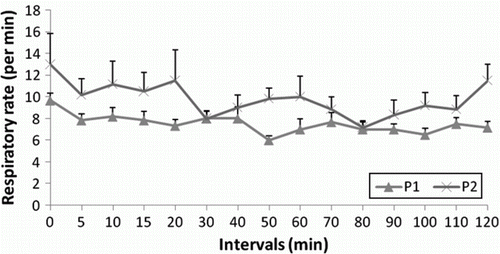Abstract
The sedative, dose sparing, cardiopulmonary and haemodynamic effects of medetomidine-butorphanol and midazolam-butorphanol, on thiopental-propofol anaesthesia were evaluated in six healthy male water buffaloes (2 to 3 years; 290 to 325 kg). Group P1 received medetomidine (2.5 µg/kg) + butorphanol (0.05 mg/kg) intravenously, while in group P2 midazolam (0.25 mg/kg) + butorphanol (0.05 mg/kg) were used intravenously at 7 days interval. After 15 min of premedication, anaesthesia was induced by 5% thiopental sodium intravenously. The anaesthesia was maintained with continuous intravenous infusion (CII) of 1% propofol in both groups up to 120 min and the depth was determined by towel clamp method. Cardio-respiratory and haemodynamic parameters were assessed up to 120 min after preanaesthetic administration. Medetomidine-butorphanol produced better sedation in comparison to midazolam-butorphanol. However, this combination produced more depression of cardiovascular system during preanaesthetic period but lesser depression of cardiorespiratory dynamics in post-induction and during maintenance period and quicker recovery was observed. Significantly lesser doses of thiopental sodium were required in the animals of group P1. It can be concluded that medetomidine–butorphanol produced better quality sedation and analgesia and quicker recovery with significantly more reduction in the induction dose of thiopental sodium and propofol and lesser cardiopulmonary effects than midazolam-butorphanol in buffaloes.
Introduction
The concept of administering sedatives before an injectable anaesthetic induction agent is well accepted in veterinary practice. Medetomidine is a potent selective alpha 2-adrenergic agonist that has sedative, myorelaxant and analgesic effects. Increments of the dose do not result in qualitative changes to the effect, only the duration of anaesthesia changes (Pypendop and Verstegen Citation2000). Medetomidine has depressive cardiovascular (bradycardia, cardiac output drop, rise in systemic vascular resistance) and respiratory (bradypnoea) effects. Midazolam is a water-soluble fast acting benzodiazepine with mild cardiovascular and respiratory effects and is commonly used as a mild tranquilliser, a muscle relaxant and anticonvulsant (Lemke Citation2007). The sedative and hypnotic effects of midazolam are dose-dependent as well as dependent on route of administration. Butorphanol, a synthetic opioid, is an agonist at κ-opioid receptors and an antagonist at µ-opioid receptors (Lamont and Mathews Citation2007).
The present investigation was planned to investigate the suitability and comparison of medetomidine and midazolam in combination with butorphanol as preanaesthetic to thiopental-propofol anaesthesia in buffaloes.
Materials and methods
Six healthy male buffaloes of 2 to 3 years of age, weighing 290 to 325 kg were kept off feed for 48 hours and off water for 24 hours prior to each trial. The animals received two treatments (groups P1 and P2) randomly at 7 days interval. In group P1, medetomidine (2.5 µg/kg) (Domitor: Orion Corporation, Formos Group, Turku, Finland) + butorphanol (0.05 mg/kg) (Butrum: Aristo Pharma. Mumbai) intravenously, while in group P2 midazolam (0.25 mg/kg) (Mezolam: Neon Laboratories, Mumbai) + butorphanol (0.05 mg/kg) were used intravenously. After premedication, the animals were restrained in right lateral recumbency and anaesthesia was induced by 5% thiopental sodium (Thiosol sodium: Neon Laboratories, Mumbai) intravenously. The dose of thiopental required for induction of anaesthesia adequate to allow endotracheal intubation was determined. The anaesthesia was maintained with continuous intravenous infusion (CII) of 1% propofol in both groups up to 120 min and the depth was determined by towel clamp method.
Recovery time (RT), sternal recumbency time (SRT), standing time (ST) were recorded and the required doses and infusion rate of thiopental sodium (mg/kg) and propofol (mg/kg/min), respectively, were calculated after completion of each trial.
Heart rate, respiratory rate and rectal temperature were recorded before administration of any drug (base line) and at 5, 10, 15, 20, 30, 40, 50, 60, 70, 80, 90, 100, 110 and 120 min of anaesthesia.
A pre-heparinised polythene catheter was introduced into the jugular vein through a 12-gauge hypodermic needle and passed up to the level of right atrium or anterior vena cava. It was attached to the saline manometer filled with heparinised saline, through a three-way stopcock for recording of central venous pressure (CVP) (cm of H2O). The cuff of the non-invasive blood pressure (NIBP) monitor was applied around the base of the tail for recording mean arterial blood pressure (MAP) (mm Hg) at time 0 (base line) and at 5, 10, 15, 20, 30, 40, 50, 60, 70, 80, 90, 100, 110 and 120 min of anaesthesia. The SpO2 (%) was measured by applying the sensor of pulse oxymeter (Pulse Oxymeter: Nonin Medical Inc. Minneapolis, USA) at anal region. The animals were stabilised for half an hour before recording the base values.
The data were analysed using ANOVA for repeated measures for comparison of mean ± SE values between different groups. Paired ‘t’ test was used for comparison of mean ± SE at different time intervals with the base value of the respective treatment (Snedecor and Cochran Citation1980). For non-parametric observations Kruskal-Wallis one-way test (Siegel and Castellan Citation1988) was used to compare the means between groups.
Results and discussion
Animals of group P1 experienced better sedation than of P2 (). It was found that the combination of butorphanol and medetomidine in the present study offered advantages over the reported action of the drug when used alone. Lack of improvement in degree of sedation when butorphanol is combined with midazolam is in agreement with the findings of Dzikiti et al. (Citation2009). In P1 group the quality of analgesia was excellent. However, in P2 group the level of analgesia was graded as good (). Anaesthesia with adequate analgesic effect has been achieved by addition of 0.1 mg/kg butorphanol to medetomidine-midazolam anaesthesia in dogs (Itamoto et al. Citation2000).
Table 1. Median±SE (range) of sedation, analgesia, recovery time, sternal recumbency time and standing time and Mean±SE of induction dose of thiopental (mg/kg) and infusion rate of propofol (mg/kg/min) in buffaloes.
The values of recovery time observed in P1 and P2, groups did not differ significantly (P>0.05). However the values of sternal recumbency time (SRT) and standing time (ST) was significantly (P<0.05) higher in group P2 than in P1 (). Significantly higher values of sternal recumbency time and standing time in P2 group might be due to more amount of thiopental sodium administered for induction and the long lasting muscle relaxant effect of midazolam. The animals of P1 group required significantly (P<0.05) lesser dose of thiopental sodium for induction of anaesthesia than that of P2 group (). Medetomidine has been reported to reduce the induction dose of thiopental greatly.
HR after premedication became significantly (P<0.05) higher in P2 group than in P1 group and remained so at almost all the intervals (Figure 1). This change was related to the CNS sedative and the autonomic and peripheral vascular effects of medetomidine.
Figure 4. Mean arterial pressure (MAP) at different time intervals in the animals of P1 and P2 groups.

A Significant (P<0.01) and non significant (P>0.05) decrease in RR was observed in P1 and P2 groups, respectively (Figure 2). No significant difference in RT was noticed at any interval (Figure 3). In the animals of P1 group mean arterial pressure decreased non-significantly (P>0.05) from the base value at 5 min after premedication and remained decreased up to 40 min. After that it increased and remained non-significantly (P>0.05) higher than the base value up to 90 min. In P2 group MAP increased non-significantly (P>0.05) after 5 min of premedication, which remained so for whole of the observation period, except at one or two intervals (Figure 4). The animals of P1 group showed significant (P<0.05) increase in CVP after 5 min of premedication up to 120 min. In P2 group the CVP increased non-significantly (P>0.05) at 5 min. After 40 min it remained significantly (P<0.05) increased for rest of the observation period (). Comparison between the two groups revealed that CVP in P1 group remained significantly (P < 0.05) higher than P2 group at all the intervals. Continued maintenance of CVP at higher level in these groups might possibly have been attributed to depressive influence of medetomidine-butorphanol on the heart that gradually subsided with the elimination of the drugs as also reported by Kinjavdekar et al. (Citation2005).
Figure 5. Central venous pressure (CVP) at different time intervals in the animals of P1 and P2 groups.

A significant (P<0.05) decrease in SpO2 was observed in both groups during whole observation period. On comparison between P1 and P2 groups, no significant difference in SpO2 was noted (Figure 6). Propofol infusion has been reported to cause significant respiratory depression with decrease in all measures of ventilation in animals (Gomez-Villamandos et al. Citation2006).
Figure 6. Arterial haemoglobin oxygen saturation (SpO2) at different time intervals in the animals of P1 and P2 groups.

It can be concluded that medetomidine–butorphanol combination produced better quality sedation and analgesia with quicker recovery and significantly more dose sparing effect on induction and maintenance agents accompanied with lesser cardiopulmonary depression than midazolam-butorphanol combination to thiopental-propofol anaesthesia in buffaloes.
Acknowledgements
The authors are grateful to the Director, Indian Veterinary Research Institute for providing necessary facilities and to Mr G.S. Bisht for help with the statistical analysis.
References
- Dzikiti , TB , Stegmann , GF , Hellebrekers , LJ , Auer , REJ and Dzikiti , LN . 2009 . Sedative and cardiopulmonary effects of acepromazine, midazolam, butorphanol, acepromazine-butorphanol and midazolam-butorphanol on propofol anaesthesia in goats . Journal of South African Veterinary Association , 80 ( 1 ) : 10 – 16 .
- Gomez-Villamandos , RJ , Palacois , C , Benitez , A , Granados , MM , Dominguez , JM , Lopez , I , Ruiz , I , Agullera , E and Santisteban , JM . 2006 . Dexmedetomidine or medetomidine premedication before propofol-desflurane anaesthesia in dogs . Journal of Veterinary Pharmacology Therapy , 29 ( 3 ) : 157 – 163 .
- Itamoto , K , Hikasa , Y , Sakonjyu , I , Itoh , H , Kakuta , T and Takase , K . 2000 . Anaesthetic and cardiopulmonary effects of balanced anaesthesia with medetomidine-midazolam and butorphanol in dogs . Journal of Veterinary Medical Association , 47 ( 7 ) : 411 – 420 .
- Kinjavdekar , P , Amarpal, Singh , GR , Aithal , HP , Pawde , AM and Bist , GS . 2005 . Haemodynamic effects of spinally administered ketamine and its combination with xylazine or medetomidine in goats . Indian Journal of Veterinary Surgery , 26 ( 2 ) : 91 – 95 .
- Lamont , A and Mathews , KA . 2007 . “ Opioids, non-steroidal anti-inflammatory, and analgesic adjuvants ” . In Lumb and Jones's veterinary anaesthesia and analgesia , Edited by: Tranquilli , WJ , Thurmon , JC and Grimm , KA . 241 – 271 . Iowa : Blackwell Publishing .
- Lemke , KA . 2007 . “ Anticholinergics and sedatives ” . In Lumb and Jones's veterinary anaesthesia and analgesia , Edited by: Tranquilli , WJ , Thurmon , JC and Grimm , KA . 203 – 239 . Iowa : Blackwell Publishing .
- Pypendop , BH and Verstegen , JP . 2000 . Effects of medetomidine-Midazolam,butorphanol combination on renal cortical, intestinal and muscle microvascular blood flow in isoflurane anaesthetized dogs: a laser Doppler study . Veterinary Anaesthesia and Analgesia , 27 : 36 – 44 .
- Siegel , S and Castellan , J Jr . 1988 . Non-parameteric statistics for behavioural sciences , Singapore : Mc Graw Hill, Inc .
- Snedecor GW , Cochran WG. 1980 . Statistical methods . 9th ed. Iowa state University Press, Ames, IA .


